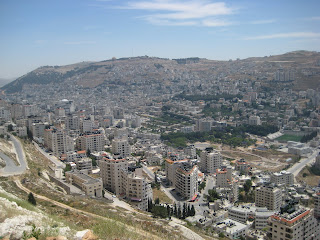Confronted by the injustices of the British colonial system as well as the Zionist threat in the first half of the 1900s, residents of Bethlehem firmly supported the cause of Palestinian nationalism. In the 1920s and 1930s, Palestinians in Bethlehem mounted several public campaigns against the British law that repealed citizenship of Palestinians but granted citizenship to Jewish immigrants. In response, Britain cracked down hard on representatives of Bethlehem. For example, in 1938, the mayor of Bethlehem, Issa Bandak, was deported by the British occupation authorities after his outspoken criticism of the British occupation. Much as Bethlehem housed Joseph, Mary, and the newborn Jesus, Bethlehem subsequently became a sanctuary for countless Palestinian refugees expelled from their villages. According to the Alternative Tourism Group (2008), population figures rose from 9,000 to nearly 20,000, while an additional 40,000 refugees stayed temporarily in Bethlehem on their way to exile in the West Bank, Jordan, or other Arab states.
I visited Bethlehem in May 2010. Today, the Bethlehem district constitutes the towns of Beit Sahour to the east and Beit Jala to the west, as well as three refugee camps (Aida, Beit Jibrin or 'Azza, and Deheisheh) to total 76,000 people. Dominated by minarets and bell towers, the city affirms its religious diversity: it has a Muslim majority (67%) and a strong Christian minority (33%). Almost every Christian community is represented: Greek Orthodox, Roman Catholic, Armenian, Lutheran and Syrian, all sharing the same Arab-Palestinian culture.
Nevertheless, there is much in-fighting between the various Christian groups over control of various religious sites in Bethlehem.
 For example, despite being a place sacred to all Christians, the Grotto of the Nativity (see photo at left) - marking the exact place of Jesus's birth - has been the object of bitter dispute between the Christian communities. In 1847, the star was stolen, and the Sultan in Istanbul was asked to arbitrate: he chose to freeze the controversy with a status quo, which pleased no one, neither France, as "the custodian of holy places, nor Tsarist Russia, as protector of all Orthodox subjects in the Ottoman empire. Finally, the star was replaced with a copy. However, prolonged disagreement over custody of these holy places served as pretext for hostilities between the great imperialist powers leading to the Crimean War of 1853-1856, with England, France, and Turkey opposing Russia. Even today, there is a complicated and detailed plan of ownership of particular places and hours for certain religious celebrations and feasts. If one religious community fails to honor another 's plan, for instance by walking down the wrong staircase at an inopportune time, then this is cause for shutting down a whole section of Bethlehem in order to rectify the situation.
For example, despite being a place sacred to all Christians, the Grotto of the Nativity (see photo at left) - marking the exact place of Jesus's birth - has been the object of bitter dispute between the Christian communities. In 1847, the star was stolen, and the Sultan in Istanbul was asked to arbitrate: he chose to freeze the controversy with a status quo, which pleased no one, neither France, as "the custodian of holy places, nor Tsarist Russia, as protector of all Orthodox subjects in the Ottoman empire. Finally, the star was replaced with a copy. However, prolonged disagreement over custody of these holy places served as pretext for hostilities between the great imperialist powers leading to the Crimean War of 1853-1856, with England, France, and Turkey opposing Russia. Even today, there is a complicated and detailed plan of ownership of particular places and hours for certain religious celebrations and feasts. If one religious community fails to honor another 's plan, for instance by walking down the wrong staircase at an inopportune time, then this is cause for shutting down a whole section of Bethlehem in order to rectify the situation.The hopeful news is that Bethlehem is celebrating its merriest Christmas in years, according to this story from NPR. Mild weather, a booming economy, and thriving tourism
 (see photo at left) are all helping to bring holiday cheer to the West Bank town. Christian tourists, Palestinian Christians, and even Palestinian Muslims from Bethlehem's refugee camps prayed side-by-side on Christmas Eve. One woman from the camp said, "Because of the hard situation and the pressure we are living in, we take advantage of any joyful moment and bring our children to play."
(see photo at left) are all helping to bring holiday cheer to the West Bank town. Christian tourists, Palestinian Christians, and even Palestinian Muslims from Bethlehem's refugee camps prayed side-by-side on Christmas Eve. One woman from the camp said, "Because of the hard situation and the pressure we are living in, we take advantage of any joyful moment and bring our children to play."It's promising to see peace in the little town of Bethlehem for even one night. But let us not forget the wall that continues to surround Bethlehem (as well as the rest of the West Bank and Gaza), the growing number of illegal Israeli settlements that are being built and are eating away at Palestinian land, the failure of peaceful negotiations between the leaders of the region, and the reality that after celebrating side-by-side with people of all faiths, many Palestinian families must return to refugee camps rather than to their rightful homes.







 In H2, I saw anti-Palestinian graffiti, such as "Gas the Arabs" written on the doors of a Palestinian home.
In H2, I saw anti-Palestinian graffiti, such as "Gas the Arabs" written on the doors of a Palestinian home. 

 notice!"). None had visited a Palestinian village, and most considered the land that they settled on to be just another part of Israel ("This land didn't belong to anyone when we arrived.").
notice!"). None had visited a Palestinian village, and most considered the land that they settled on to be just another part of Israel ("This land didn't belong to anyone when we arrived.").























